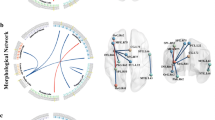Abstract
Mild cognitive impairment (MCI), often a prodromal phase of Alzheimer’s disease (AD), is frequently considered to be a good target for early diagnosis and therapeutic interventions of AD. Recent emergence of reliable network characterization techniques have made understanding neurological disorders at a whole brain connectivity level possible. Accordingly, we propose a network-based multivariate classification algorithm, using a collection of measures derived from white-matter (WM) connectivity networks, to accurately identify MCI patients from normal controls. An enriched description of WM connections, utilizing six physiological parameters, i.e., fiber penetration count, fractional anisotropy (FA), mean diffusivity (MD), and principal diffusivities (λ 1, λ 2, λ 3), results in six connectivity networks for each subject to account for the connection topology and the biophysical properties of the connections. Upon parcellating the brain into 90 regions-of-interest (ROIs), the average statistics of each ROI in relation to the remaining ROIs are extracted as features for classification. These features are then sieved to select the most discriminant subset of features for building an MCI classifier via support vector machines (SVMs). Cross-validation results indicate better diagnostic power of the proposed enriched WM connection description than simple description with any single physiological parameter.
Access this chapter
Tax calculation will be finalised at checkout
Purchases are for personal use only
Preview
Unable to display preview. Download preview PDF.
Similar content being viewed by others
References
Bassett, D.S., Bullmore, E.: Small-world brain networks. The Neuroscientist 12(6), 512–523 (2006)
Bischkopf, J., Busse, A., Angermeyer, M.C.: Mild cognitive impairment - a revies of prevalence, incidence and outcome according to current approaches. Acta Psychiatr Scand 106, 403–414 (2002)
Dineen, R.A., Vilisaar, J., Hlinka, J., Bradshaw, C.M., Morgan, P.S., Constantinescu, C.S., Auer, D.P.: Disconnection as a mechanism for cognitive dysfunction in multiple sclerosis. Brain 132 (Pt. 1), 239–249 (2009)
Fan, Y., Resnick, S.M., Wu, X., Davatzikos, C.: Structural and functional biomarkers of prodromal Alzheimer’s disease: A high-dimensional pattern classification study. NeuroImage 41, 277–285 (2008)
Gong, G., He, Y., Concha, L., Lebel, C., Gross, D.W., Evans, A.C., Beaulieu, C.: Mapping anatomical connectivity patterns of human cerebral cortex using in vivo diffusion tensor imaging tractography. Cerebral Cortex 19, 524–536 (2009)
Greicius, M.D., Srivastava, G., Reiss, A.L., Menon, V.: Default-mode network activity distinguishes Alzheimers disease from healthy aging: Evidence from functional MRI. PNAS 101(13), 4637–4642 (2004)
Grundman, M., Petersen, R.C., Ferris, S.H., Thomas, R.G., Aisen, P.S., Bennett, D.A., et al.: Mild cognitive impairment can be distinguished from alzheimer disease and normal aging for clinical trials. Arch. Neurol. 61(1), 59–66 (2004)
Guyon, I., Weston, J., Barnhill, S., Vapnik, V.: Gene selection for cancer classification using support vector machines. Machine Learning 46(1-3), 389–422 (2004)
Hagmann, P., Cammoun, L., Gigandet, X., Meuli, R., Honey, C.J., Wedeen, V.J., Sporns, O.: Mapping the structural core of human cerebral cortex. PLoS Computational Biology 6, e159 (2008)
Hagmann, P., Kurant, M., Gigandet, X., Thiran, P., Wedeen, V.J., Meuli, R., Thiran, J.P.: Mapping human whole-brain structural networks with diffusion MRI. PLoS ONE 2, e597 (2007)
Leemans, A., Jeurissen, B., Sijbers, J., Jones, D.K.: ExploreDTI: A graphical toolbox for processing, analyzing, and visualizing diffusion MR data. In: 17th Annual Meeting of Intl. Soc. Mag. Reson. Med., p. 3537 (2009)
Rakotomamonjy, A.: Variable selection using svm based criteria. Journal of Machine Learning Research: Special issue on special feature 3, 1357–1370 (2003)
Rose, S.E., Janke, A.L., Chalk, J.B.: Gray and white matter changes in alzheimer’s disease: A diffusion tensor imaging study. Journal of Magnetic Resonance Imaging 27(1), 20–26 (2007)
Sporns, O., Tononi, G., Kotter, R.: The human connectome: a structural description of human brain. PLoS Computational Biology 1, e42 (2005)
Sporns, O., Zwi, J.D.: The small world of the cerebral cortex. Neuroinformatics 2, 145–161 (2004)
Tzourio-Mazoyer, N., Landeau, B., Papathanassiou, D., Crivello, F., Etard, O., Delcroix, N., Mazoyer, B., Joliot, M.: Automated anatomical labeling of activations in SPM using a macroscopic anatomical parcellation of the MNI MRI single-subject brain. Neuroimage 15, 273–289 (2002)
Xu, D., Mori, S., Shen, D., van Zijl, P.C.M., Davatzikos, C.: Spatial normalization of diffusion tensor fields. Magnetic Resonance in Medicine 50(1), 175–182 (2003)
Yap, P.T., Wu, G., Zhu, H., Lin, W., Shen, D.: Fast tensor image morphing for elastic registration. In: Yang, G.-Z., Hawkes, D., Rueckert, D., Noble, A., Taylor, C. (eds.) MICCAI 2009. LNCS, vol. 5761, pp. 721–729. Springer, Heidelberg (2009)
Author information
Authors and Affiliations
Editor information
Editors and Affiliations
Rights and permissions
Copyright information
© 2010 Springer-Verlag Berlin Heidelberg
About this paper
Cite this paper
Wee, CY. et al. (2010). Accurate Identification of MCI Patients via Enriched White-Matter Connectivity Network. In: Wang, F., Yan, P., Suzuki, K., Shen, D. (eds) Machine Learning in Medical Imaging. MLMI 2010. Lecture Notes in Computer Science, vol 6357. Springer, Berlin, Heidelberg. https://doi.org/10.1007/978-3-642-15948-0_18
Download citation
DOI: https://doi.org/10.1007/978-3-642-15948-0_18
Publisher Name: Springer, Berlin, Heidelberg
Print ISBN: 978-3-642-15947-3
Online ISBN: 978-3-642-15948-0
eBook Packages: Computer ScienceComputer Science (R0)





